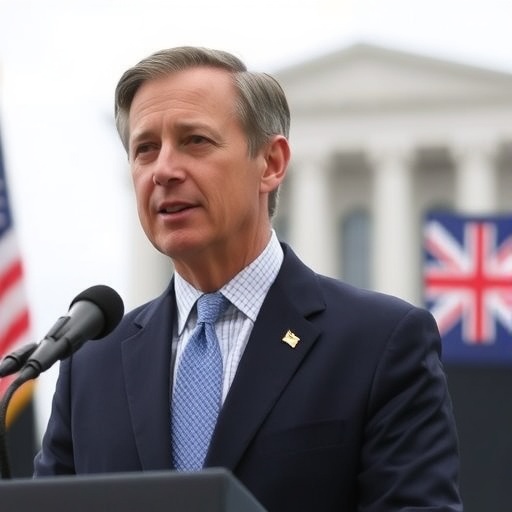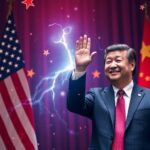Treasury Secretary Scott Bessent Unveils U.S.-China trade Framework: Dodging 100% Tariffs and Boosting American Farmers
In a stunning diplomatic breakthrough, Treasury Secretary Scott Bessent announced today that the United States and China have forged a comprehensive framework to dismantle the long-standing U.S.-China trade war, averting the imposition of crippling 100% tariffs that loomed over critical sectors. This agreement not only secures massive agricultural purchases to support struggling U.S. farmers but also paves the way for enhanced Chinese cooperation on curbing the flow of fentanyl precursor chemicals into America. The deal, set to be finalized at an upcoming summit between President Donald Trump and Chinese President Xi Jinping in South Korea this week, marks a pivotal shift in bilateral relations, promising relief from years of economic tension.
The revelation comes at a time when global markets are jittery, with U.S.-China trade tensions having cost American businesses billions and disrupted supply chains worldwide. Bessent, speaking from the White House briefing room, described the framework as “a game-changer that prioritizes American workers and security while opening doors for fair trade.” This development follows months of backchannel negotiations amid escalating rhetoric, where threats of 100% tariffs on Chinese imports had raised fears of a full-blown economic decoupling.
Averting Catastrophic 100% Tariffs on Key Imports
The specter of 100% tariffs had hung over U.S.-China trade like a dark cloud, threatening to double the cost of everything from electronics to machinery. Under the new framework, both nations have committed to rolling back these punitive measures, starting with a phased reduction of existing tariffs averaging 25% on over $300 billion in Chinese goods. According to Bessent, this de-escalation will prevent an estimated $500 billion in additional economic losses for U.S. consumers and businesses in the coming year.
Historical context underscores the urgency of this move. The trade war, ignited in 2018 during Trump’s first term, imposed tariffs that led to a 20% drop in U.S. agricultural exports to China, the world’s largest market for American soybeans and pork. Economists from the Peterson Institute for International Economics estimate that the conflict has already shaved 0.5% off U.S. GDP annually. “This framework isn’t just about numbers; it’s about restoring stability to families and farms hit hardest by these tariffs,” Bessent emphasized in his address.
Market reactions were swift and positive. The Dow Jones Industrial Average surged 2.5% in afternoon trading, while soybean futures on the Chicago Board of Trade jumped 15%, signaling investor confidence in the deal’s viability. Experts like Dr. Emily Chen, a trade policy analyst at Brookings Institution, hailed it as “a pragmatic pivot that avoids the mutually assured economic destruction of unchecked tariffs.”
Securing Billions in Agricultural Purchases for U.S. Farmers
At the heart of the agreement lies a lifeline for American agriculture, with China pledging to purchase up to $50 billion in U.S. farm products over the next two years. This includes soybeans, corn, beef, and pork—staples that have suffered under the trade war’s crossfire. For farmers in the Midwest heartland, where bankruptcies spiked 20% in 2019 due to lost Chinese markets, this represents a much-needed windfall.
Take the story of Mark Thompson, a soybean farmer from Iowa whose exports plummeted from 40% to under 10% after tariffs hit. “We’ve been hanging on by a thread, borrowing to keep the lights on,” Thompson told reporters last year. Now, with this framework, organizations like the American Farm Bureau Federation project a 30% revenue boost for exporters, potentially saving 100,000 family farms from foreclosure.
Scott Bessent detailed the specifics during a press conference, noting that the purchases will be monitored through a joint U.S.-China agricultural working group to ensure compliance. “This isn’t charity; it’s a balanced trade commitment that levels the playing field,” he said. Data from the U.S. Department of Agriculture supports the optimism: In 2022, China bought $40 billion in U.S. ag products pre-tariff hikes, and restoring that volume could add $10 billion to rural economies overnight.
The deal also incorporates technology transfers for sustainable farming practices, allowing U.S. innovators to access Chinese markets without intellectual property theft concerns—a persistent grievance in past negotiations. As one farm lobbyist put it, “This framework turns the page on pain and plants seeds for prosperity.”
China’s Pledge to Curb Fentanyl Precursor Shipments
Beyond economics, the framework addresses a pressing public health crisis: the opioid epidemic fueled by fentanyl. China has agreed to stricter controls on precursor chemicals, which are overwhelmingly produced there and smuggled into the U.S. via Mexico. This cooperation includes enhanced regulatory oversight, real-time intelligence sharing, and joint enforcement operations—steps that could drastically reduce the 100,000 annual overdose deaths linked to fentanyl in America.
The fentanyl issue has been a flashpoint in U.S.-China relations, with Trump repeatedly calling it “the worst drug crisis in history.” Under the agreement, Beijing commits to banning exports of key precursors like 4-AP and NPP, substances that evade current international controls. U.S. Customs and Border Protection data shows that 90% of seized fentanyl originates from Chinese-sourced chemicals, making this pledge a cornerstone of the deal.
“We’re not just talking trade; we’re saving lives,” Bessent declared, quoting a DEA official who estimated the measures could cut illicit flows by 50% within a year. Advocacy groups like Families Against Fentanyl praised the move, with founder Breanne Meda stating, “This is the first real multilateral action we’ve seen—it’s a beacon of hope for grieving families.” The framework also ties chemical export licenses to trade compliance, creating incentives for sustained cooperation.
Critics, however, caution that enforcement will be key. Past promises from China have faltered due to lax implementation, but this deal includes verifiable metrics, such as quarterly audits by international bodies like the UN Office on Drugs and Crime.
Trump-Xi Summit in South Korea: Finalizing the Path Forward
The framework’s true test will come at the highly anticipated summit between Trump and Xi Jinping in South Korea this week, hosted on neutral ground to facilitate candid dialogue. Scheduled for Thursday in Seoul, the meeting will iron out remaining details, including timelines for tariff reductions and agricultural delivery schedules. Sources close to the negotiations indicate that both leaders view this as an opportunity to reset relations strained by technology disputes and human rights concerns.
Trump, who has long touted his deal-making prowess, tweeted earlier today: “Big progress with China—tariffs down, farmers up, drugs stopped. Heading to South Korea to seal the win for America!” Xi, in a statement from Beijing, echoed the sentiment: “This framework promotes mutual benefit and win-win cooperation in U.S.-China trade.” The choice of South Korea as the venue is strategic, leveraging Seoul’s role as a key ally to both powers and its history of hosting pivotal talks, like the 2018 inter-Korean summit.
Diplomatic insiders predict the summit could expand the framework to include intellectual property protections and investment flows, potentially unlocking $100 billion in bilateral trade growth by 2025. Security will be tight, with U.S. and Chinese delegations numbering over 200 each, amid concerns over regional tensions involving Taiwan and the South China Sea.
As preparations intensify, global observers are watching closely. The summit isn’t just about finalizing paperwork; it’s a stage for Trump and Xi to project leadership in a multipolar world, where U.S.-China trade dynamics influence everything from climate accords to tech standards.
Looking ahead, this framework signals a thaw in frosty relations, but challenges remain. Implementation hurdles, domestic political pressures, and unforeseen global events—like supply chain disruptions from ongoing conflicts—could test the agreement’s resilience. Yet, for now, the averted 100% tariffs and secured gains offer a tangible victory, fostering optimism that U.S.-China trade can evolve from confrontation to collaboration. Economists forecast a 1-2% uplift in global growth if the deal holds, benefiting consumers worldwide with lower prices and stable supplies. As Bessent wrapped up his remarks, he urged patience: “This is the end of the beginning—a framework built to last, delivering real results for Americans.”








